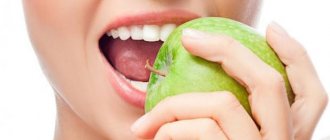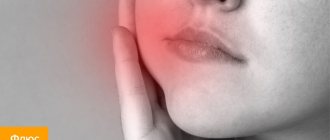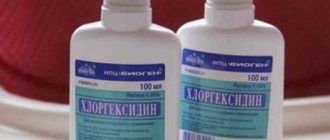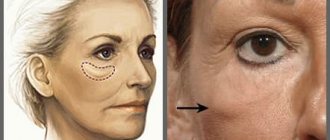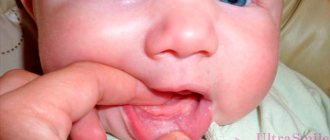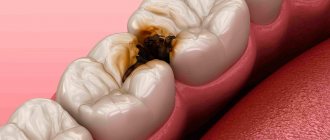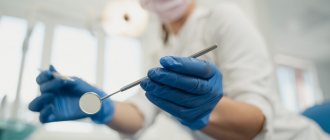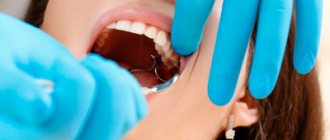The inflammatory process in the subgingival and subperiosteal jaw area with purulent formation (abscess) is called gumboil or periostitis. Its main cause is inflammation of the tooth root. A visual sign of the disease is a swollen cheek (a “bump” forms in the problem area).
Most of us prefer to treat flux on the gums at home, but periostitis is a fairly serious disease, the absence or untimely treatment of which poses a threat to the health of the entire body. In the article we will talk about the symptoms, causes of periostitis, and how to cure gumboil.
Content:
- Forms of release of antibacterial agents used in dentistry
- Contraindications to treatment of flux with antibiotics
- What undesirable effects are possible during the course of medication?
- When you can't do without antimicrobials
- Which antibiotic to choose
- Danger of overdose
- Why you can’t self-medicate
Antibiotics are drugs that exhibit pronounced antimicrobial properties.
They block the growth and spread of pathogenic microorganisms. Dentists prescribe drugs from this pharmacological group for inflammatory gum diseases, purulent processes, and during the recovery period after surgical interventions in the oral cavity. Antibiotics also help with flux. A patient with an inflamed tooth root should not independently select an antibacterial composition. It is important to consider:
- degree of spread of the pathological process;
- associated disorders;
- sensitivity of the pathogen to active antimicrobial compounds;
- speed of regenerative processes.
If you take the wrong antibiotic for flux, the disease will continue to progress. This will disrupt the intestinal microflora. Therefore, never self-medicate.
Folk recipes
Herbs and plant extracts have a beneficial effect on oral tissues. They can be used to relieve inflammation. When dealing with flux, you should arm yourself with:
- Oak bark. An infusion is prepared from it: pour two spoons into 200 ml of boiling water and wait for one hour. After filtering, the composition is ready for use. All products based on oak bark stain teeth. This is their significant drawback.
- Sage. You should mix a teaspoon of aromatic dry raw materials with a glass of hot boiling water. After half an hour, filter. During the procedure, the medicine should be slightly warm.
- Chamomile. Very popular for various dental diagnoses. Excellently suppresses inflammatory processes. Antiseptic. It can be combined with string and yarrow. The preparation recipe is standard: a tablespoon of vegetable mixture per glass of boiling water.
- Propolis. Suitable for making tinctures with alcohol. It must be infused strictly at room temperature. Dilute a teaspoon in a cup of water and rinse the flux in the morning, afternoon and evening.
Forms of release of antibacterial agents used in dentistry
Dentists use drugs in the form of:
- Ointments and gels. Designed for local treatment of affected gums. Qualitatively relieve inflammation and reduce pain symptoms. As a rule, ointment and gel formulations are applied two to four times a day. It is important to use the medication regularly and strictly according to the regimen selected by a specialist. Only then will it be possible to achieve positive dynamics.
- Tablets and capsules. The most popular types of antimicrobial agents intended for oral administration. The daily dosage is determined by the doctor. When deciding which antibiotics to prescribe, the doctor must take into account the patient’s health condition. It is unacceptable to include in therapy drugs that can aggravate the course of existing diseases of internal organs.
- Solutions for injection. Injections are given intravenously or intramuscularly. This is the most effective option for antibacterial therapy. It is used for complicated and advanced forms of dental disease.
Propolis tincture
Propolis tincture has a strong anti-inflammatory effect and wound healing effect. Tannins relieve pain well. And essential oils and flavonoids are powerful natural antibiotics. To treat gumboil, 15 ml of propolis tincture is diluted in half a glass of warm boiled water. The solution is used for rinsing. You can moisten a cotton pad with undiluted tincture and apply it to the inflamed area overnight.
Treating flux with propolis in its natural form is also effective. It must be chewed throughout the day until the toothache disappears.
Propolis tincture can be purchased at a pharmacy or prepared at home yourself. To do this, 20 g of propolis is finely crushed and filled with 100 ml of 70% medical ethyl alcohol. Infused in a dark glass bottle for 14 days.
Contraindications to treatment of flux with antibiotics
It is prohibited to use antimicrobial agents that are contraindicated for the patient. Pregnant and lactating women are prescribed medications in this group only if the benefits expected for the mother outweigh the possible risks to the fetus. For young children with weakened immune systems, they always try to eliminate inflammation of the oral tissues without antibiotics.
Before starting antibacterial therapy, it is recommended that you carefully read the information provided in the instructions. Side effects, contraindications, and maximum daily dosages are indicated there. This data is very important. It is unacceptable to ignore them. If you have any questions regarding drug correction, you should consult your dentist.
Important: combination of antibiotic and antiseptics
When treating gum inflammation (chronic generalized periodontitis), antibiotics alone are not enough.
In this case, treatment should be comprehensive - removal of dental plaque, antibacterial therapy, antiseptic mouth rinses + the use of a special anti-inflammatory gel for gums. Now we would like to tell you why it is important to combine antibiotics with mouth rinses with antiseptic solutions when treating periodontitis. In case of aggressive periodontitis, as well as moderate and severe periodontitis, in addition to pathogenic bacteria, fungal flora (fungi of the genus Candida) is also present in the periodontal pockets. The presence of fungal flora in periodontal pockets actually has a very important impact on the effectiveness of antibacterial therapy of gums for periodontitis. The fact is that fungi of the genus Candida form so-called “microbial associations” with pathogenic bacteria, making them insensitive to many antibiotics.
There are scientific works (source) that show the comparative effectiveness of different types of antiseptics and their different concentrations in the treatment of chronic generalized periodontitis, in which Candida fungi are present in periodontal pockets. Clinical studies show that there are only 2 antiseptics that are simultaneously effective against common pathogenic bacteria and Candida fungi for periodontitis. This is primarily 0.2% chlorhexidine, and also to a lesser extent 0.1% hexitidine (the drug “Hexoral solution”).
Important: most often, Candida fungi in periodontitis occur in the following categories of patients. For example, if your gum inflammation is of a long-term chronic nature (i.e., we are talking about moderate or severe periodontitis), with aggressive periodontitis. And also, if you smoke, or eat a lot of carbohydrates, or if you have concomitant chronic tonsillitis, or gastrointestinal diseases, or in the past - at least 1 case of candidiasis (thrush) of any localization.
→ The best mouth rinses for periodontitis, → Rating of the best gels for gums.
Antibiotics for implantation –
A separate issue of the use of antibiotics is their use in implantology - in preparation for surgery, its accompaniment and use in the early postoperative period - for the prevention of infectious complications, as well as for the treatment of already existing infectious complications (peri-implantitis). Read more about the choice of antibiotics in these cases in the article:
→ Choice of antibiotics in implantology
What undesirable effects are possible during the course of medication?
Side effects depend on the active compound of the particular drug and the individual characteristics of the patient’s body. Common complications caused by long-term antibiotic therapy include :
- Disturbances in the gastrointestinal tract, dysbacteriosis. The conditions are manifested by nausea, loss of appetite, diarrhea, abdominal pain, and flatulence.
- Decreased performance, muscle weakness.
- Dizziness.
- Allergic reactions. Usually these are skin rashes and itching. Swelling also often develops.
If the antibiotic is poorly tolerated, a repeated consultation with the dentist is indicated. It is possible that the doctor will replace the medication with a safer analogue.
Symptoms
Symptoms of periostitis manifest themselves in the most unpleasant ways. At the initial stage, aching, tolerable pain when pressing on the tooth. After a few days, the pain intensifies and the gums in the area of the diseased tooth begin to become inflamed. An abscess forms with the release of pus, the pain is radiated to the facial muscles.
If you ignore the symptoms, the body temperature rises to 38-39 degrees. The pain radiates through the nerve endings to the ear, temple and eye. A person is weak and unable to do anything, he only thinks about pain.
There are people who endure to the last, then with severe inflammation a fistula appears, from which pus comes out, the swelling subsides a little. At this stage, if nothing is done, the disease will progress to a more severe chronic stage.
It is worth noting the fact that neglecting the signals of your body can lead to irreversible consequences; at best, the doctor will remove the tooth.
When you can't do without antimicrobials
Dentists prescribe antimicrobial agents if:
- inflammation is caused by streptococcal or staphylococcal infection;
- soft tissues in different parts of the oral cavity are infected;
- purulent complications should be urgently prevented or eliminated;
- inflammation progresses despite treatment;
- The patient came to the dental clinic with advanced disease.
Since there is not always time to identify the causative agent of the disease, doctors usually select broad-spectrum antibacterial drugs. They quickly cope with negative symptoms.
Why does pathological formation occur?
The main reason for the development of the pathological process is injury to the soft tissue of the gums. The disease also often develops against the background of:
- Caries.
- Inflammation of the gum pocket.
- Violation of the rules of oral hygiene.
- Infectious diseases: tonsillitis, furunculosis, etc.
Pathology is characterized by gradual development:
- The initial stage is characterized by the appearance of mild pain when touching the gums.
- In the second stage, swelling and redness of the gums develop, and the pain becomes intense.
- If left untreated, pus appears in the gum pocket, body temperature rises, and swelling spreads to the cheek.
- Next, an extensive inflammatory process develops, characterized by the appearance of acute throbbing pain and an increase in the area of edema. The patient's general condition deteriorates significantly.
Which antibiotic to choose
It is impossible to name one medication that would suit everyone. Only a doctor can determine the drug that is effective for a particular patient. To do this, he conducts a survey, examines the oral cavity and performs some diagnostic manipulations.
Among the antimicrobials most often used in dentistry, it is worth highlighting:
- Ciprofloxacin. Broad-spectrum composition. Belongs to the group of second generation fluoroquinolones. Effectively destroys Aggregatibacter actinomycetemcomitans - a gram-negative facultative anaerobic bacterium that causes periodontitis and periodontal disease. It is noteworthy that the medicine practically does not change the microflora of the oral cavity. Therefore, dentists classify it as safe.
- Metronidazole. It is used in the relief of pathologies caused by protozoa, oral bacteria and Trichomonas. Helps with damage to tooth roots, purulent processes, phlegmon, periostitis, abscess, alveolitis and many other diseases of the mouth.
- Doxycycline. Prescribed by specialists at the dental center if severe inflammation of soft tissues, gingivitis, granuloma, or damaged tooth roots are diagnosed.
- Tetracycline. Allows you to cope with the destruction of the periosteum and periodontitis. It has a unique ability to accumulate in the gingival fluid of periodontal pockets, due to which it quickly destroys pathogenic microorganisms.
- Azithromycin. Used in the treatment of inflamed periosteum in patients allergic to beta-lactam compounds. Drink once a day for three days. Moreover, its therapeutic effect persists for several days after the end of the course.
- Amoxiclav. Its active compound is amoxicillin supplemented with clavulanic acid. It is in such a “bundle” that the connection manifests itself best. If you use it in the fight against gumboil in the form of monotherapy, you are unlikely to be cured.
- Lincomycin. It has a pronounced bacteriostatic effect - quickly stops the proliferation of harmful bacteria, which is very important for periosteal pathologies. Destroys streptococci, staphylococci.
Most of the medications listed are available in pharmacies with a doctor's prescription. This once again proves that it is impossible to try to overcome toothache without ever visiting the dentist.
How to rinse your mouth with flux?
Flux or periostitis is an inflammatory process of the jaw with the formation of a cavity with purulent contents. Rinsing is just one of the auxiliary measures. They are prescribed after opening and draining the abscess.
When carrying out procedures, adhere to the following rules :
- The manipulations are essentially oral baths. You need to take a small amount of solution into your mouth, hold it for a couple of minutes near the sore spot, spit it out and repeat several times. Intense exposure is prohibited, as it can displace the drainage and disrupt the wound healing process.
This recommendation is especially relevant after the removal of the tooth that caused the development of the disease. If you ignore the advice, a blood clot will be washed out of the hole and alveolitis will develop.
- The liquid should be lukewarm. Cold and hot temperatures are not acceptable.
- You cannot heat the affected area, apply warming lotions, compresses, or make bandages. Heat accelerates the proliferation of pathogenic microorganisms and the formation of purulent exudate.
- It is necessary to treat the mouth once every 1 – 2 hours.
- Rinsing with flux is mandatory after every meal and before bed.
Important! Children are allowed to perform the manipulation only if they have already learned to rinse their mouth. Otherwise, babies will swallow all or most of the medicine.
Rinsing for flux is more of a mouth bath.
Danger of overdose
Some patients believe that by using higher doses of medication they will be able to recover faster. This is wrong. In the case of any medications, it is important to adhere to the dosage and regularity of use.
If you deliberately increase the number of tablets consumed per day, an overdose will develop. This is an insidious condition that is harmful to health. In the case of incorrect antibiotic therapy, it manifests itself:
- vomiting, nausea;
- dizziness;
- loss of strength;
- discomfort in the abdomen, exacerbation of gastrointestinal diseases (if any);
- allergic rashes.
If an overdose occurs, you should immediately interrupt treatment and consult a doctor.
Aloe
Aloe juice is rich in active substances that promote wound healing, relieve inflammation and relieve pain. Tanning components and enzymes have a detrimental effect on various microorganisms, which makes this plant indispensable in the treatment of purulent diseases.
For periostitis, a paste made from fresh aloe leaves and celandine helps well. The components are crushed in equal proportions in a blender to a homogeneous paste, which is wrapped in several layers of gauze and applied to the flux area for 2 hours. Repeat the procedure three times a day.
Fresh plant juice is diluted with warm boiled water in equal quantities. Rinse your mouth with the solution every 2-3 hours until the acute manifestations subside. After which the procedure can be repeated 2-3 times a day until complete recovery.
Aloe juice quickly loses its properties, so it can only be stored for a few hours. It's better to use freshly prepared one.
Why you can’t self-medicate
Antimicrobial agents alone are not able to cure gumboil. Therefore, there is no point in carrying out antibacterial therapy at home and postponing a visit to the dental clinic. Drug treatment begins after cleansing and filling the roots, draining the inflammatory focus. Therefore, what precedes it:
- Opening the crown of a diseased tooth.
- Placement of a special composition into the carious cavity and installation of a temporary filling.
- Removing temporary filling material, cleaning and closing the canals.
- Fixation of a permanent filling.
At the same time, an incision is made in the gum in the area where the “bump” is located so that the pus comes out naturally.
Antibacterial agents are only one of the stages of complex therapy for inflammation of the periosteum of the jaw. It is often possible to do without them. To do this, you do not need to wait until the pain becomes unbearable and the gums become swollen. It is recommended to go to the dentist immediately - as soon as a purulent “bump” appears or a tooth begins to ache.
Types of disease
Flux is classified according to its development into the following types:
- Odontogenic. Pathology occurs against the background of advanced diseases of teeth and gums,
- Hematogenous. The disease develops when infection penetrates through the circulatory system.
- Lymphogenic. The cause of the disease is pathogenic microorganisms in the lymphatic system.
- Traumatic. Flux occurs at the site of injury to the periosteum, often after unsuccessful dental procedures during dental treatment.
According to the degree of spread, the following types of disease are distinguished:
- An ordinary flux that does not affect the periosteum.
- Fibrous flux, characterized by the onset of inflammation in the tissues of the periosteum.
- Orthodogenic flux, which develops as a complication - osteomyelitis, which requires tooth extraction.
- Albuminous flux, characterized by a chronic course, subfertile temperature and the occurrence of suppuration.
